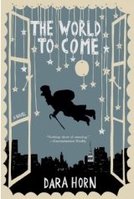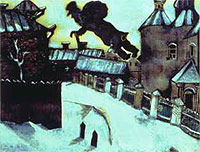 I picked up a copy of The World to Come for my vacation to Amsterdam, because I had read some great reviews, and it caught my eye because both this book and her other book (which I just ordered) both have to do with art. The art in question is a painting by Chagall, who also appears as a character in the novel. It's a sweeping story about multiple generations of a Jewish family, with dramatic themes of trust, creativity, and time. Horn is an expressive writer, whose descriptions of color and space easily match the joyous visuals of Chagall's work. She writes:
I picked up a copy of The World to Come for my vacation to Amsterdam, because I had read some great reviews, and it caught my eye because both this book and her other book (which I just ordered) both have to do with art. The art in question is a painting by Chagall, who also appears as a character in the novel. It's a sweeping story about multiple generations of a Jewish family, with dramatic themes of trust, creativity, and time. Horn is an expressive writer, whose descriptions of color and space easily match the joyous visuals of Chagall's work. She writes:Color, color, bold, loud colors, colors that sang, colors that hummed, colors that screamed, colors that sobbed, or more often than anything else, colors that seethed, angry, bitter, unlooked at, unnoticed, darkening not from age but from loneliniess, from knowing that they do not exist without someone to see them - Sara did not merely see them, but heard them, smelled them, tasted them, touched them.The World to Come has the emotional complexities of Safran Foer's excellent Everything Is Illuminated and Extremely Loud and Incredibly Close. Like Safran Foer, Horn sensitively blends the highly charged histories of her characters - involving real-life events like war and terrorist attacks - without taking advantage of the emotional power or cheapening the meaning.
For me, the most interesting parts of the book were those in which the characters grappled with the concepts of what happens to us before we're born and after we die - and how the cycle of life so frequently occurs at the same time - that we lose and gain family members at the same time (a phenomenon I'm experiencing myself lately). She ties these ideas to Jewish parables (by the writer Der Nister, or Pinkhas Kahanovitch), allowing the characters to explore them spiritually and independently.

According to an interview in the back of the book (the paperback), Horn began writing this story after a Chagall painting, Study for 'Over Vitebsk,' (the same work in the book) was stolen from the Jewish Museum in New York. You can learn more about that story by listening to this audio report from NPR. Read the first chapter online, but I encourage you to read the rest as well.


3 comments:
I want to read this, too!!! I'm determined to quit my job and spend ALL my time reading. My to-read list is so long (small moan). Will you call my boss and explain that I should still be entitled to a salary and dental insurance even if I stop showing up most of the time?
Oh, it's so good, Sonya - you'll love it. I'd love to have a look at your to-read list. I don't have one written down so much as a stack next to my bookshelves. I've often wondered about a job where I read for a living - proofreader/reviewer/editor/something like that?
Hi Kelly! I found this blog surfing off of Lyman's (he's my cousin...); love your reflections on literature. I'll add this to my frequent-read blogs list. Maybe you'd do us all a favor of adding a spot on your sidebar with the titles in your pile of books waiting to be read?
Happy Holiday(s)!
Kathy
Post a Comment